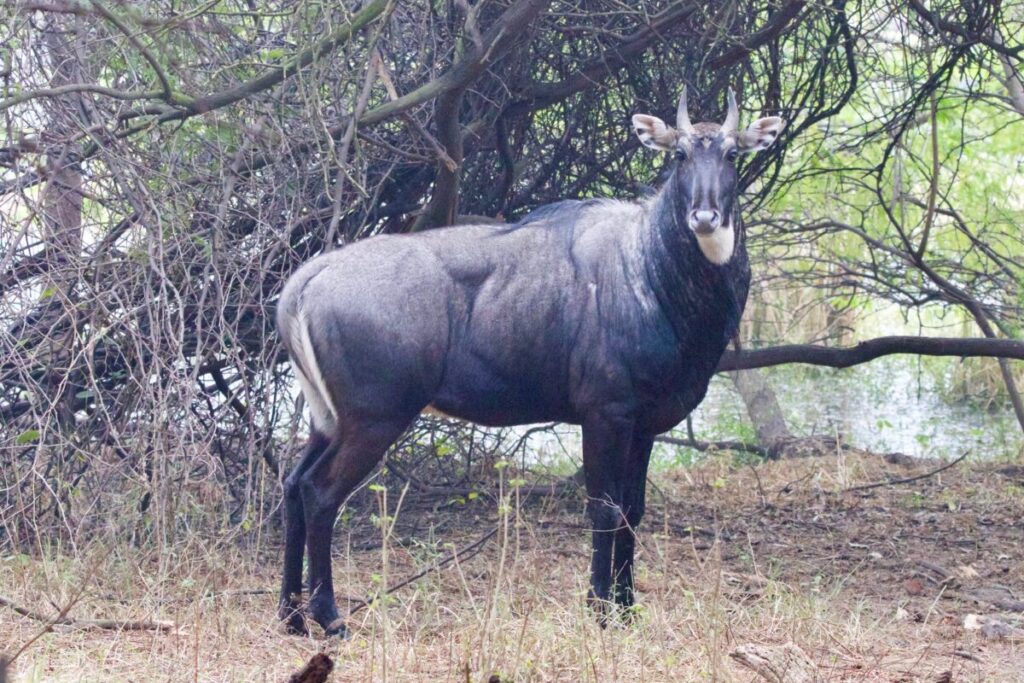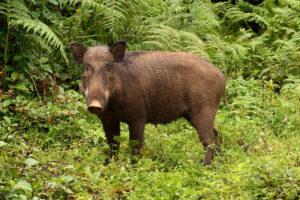Controlling Population Of Animals In Conflict
Jan 10, 2024 | Pratirodh Bureau
A nilgai at Sultanpur National Park, Haryana. The study proposes capturing nilgai using the boma method for translocation (Photo by Kandukuru Nagarjun/Flickr)
- A new report by the Wildlife Institute of India suggests population control of four species that are most in conflict with humans.
- The study was done in pursuit of a humane solution to increasing conflicts with certain species, as some states were considering culling.
- Researchers insist that the report provides only baseline information and the solutions will remain on paper without long-term study and data collection.
A recent study addresses rising negative interactions between humans and animals and proposes population control measures as long-term solutions, while emphasising the need for continued research.
In states such as Himachal Pradesh, Uttarakhand and Kerala, where conflicts with certain animals such as rhesus macaques and wild boars reached a tipping point, the animals have been tagged vermin and cullings are mooted. As a humane solution to the problem, the Wildlife Institute of India, after three years of research into the matter, has come up with mitigation measures including immuno-contraception for population control of species most-in-conflict. The four species studied were rhesus macaque (Macaca mulaa), nilgai (Boselaphus tragocamelus), wild pig (Sus scrofa) and elephant (Elephas maximus).
The WII researchers maintain that the current project was aimed only at establishing baseline information for possible strategies for future interventions. “The project was envisioned as a minimum 10-year project, not a one-off short-term study to be implemented on the field immediately,” said Vishnupriya Kolipakam, one of the researchers involved in the study.
Sterlisation As An Alternative Solution To Culling
The idea was mooted with “macaque trouble” within the WII campus in Dehradun, Uttarakhand. The scientists at WII knew that the most popular solution to negative interactions with animals — of translocating the problem species, thereby moving the problem elsewhere — was unscientific. A proposal to control the population of the macaques was submitted to the Ministry of Environment, Forest and Climate Change (MoEFCC) that felt the idea could be extended to certain other species, too. According to Qamar Qureshi, a professor who led the WII project titled Population management of species involved in human wildlife conflict, the team started with understanding the population ecology of the four species, necessary for deriving a solution.
The study areas were within a five-km-radius of the Wildlife Institute of India in Dehradun and Rajaji Tiger Reserve in Uttarakhand for rhesus macaques; Pench and Panna Tiger Reserves in Madhya Pradesh for nilgai and wild pig; Hassan and Kodagu districts of Karnataka for Asiatic elephants and wild pigs. The report says that the feasibility of using a particular population control method in target species or population depends on a myriad of parameters including movement pattern, population, sex ratios, age structure and estimated rate of increase of the target species in study areas.
The study suggests mass capture and surgical sterilisation for rhesus macaques; immuno-contraception using drugs like Porcine Zona Pellucida (PZP) found to be effective in African elephants for Asiatic elephants; mass capture and release in protected areas with low prey density for wild pigs and nilgai, using boar buster cages and boma method respectively. Boma method is an African technique used to lure animals into an enclosure by chasing them through a funnel-like fencing made of cloth.
Anish Andheria, the president and the CEO of the Wildlife Conservation Trust, who was not part of the study, said that it was a good idea to come up with population control strategies for three species — rhesus macaques, nilgai and wild boar, as the population of those species increased primarily due to humans. “Indiscriminate disposal of food waste, habitat destruction and the absence of predators have all contributed to the increase in their population and the conflict,” he said. In most cases, people retaliate to animal depredation by killing these animals through various means including electrocution which could also harm other animals like leopards who live near human habitations. Andheria finds population control as a viable option to avoid such situations.
Should The Population Of An Endangered Species Be Controlled?
Some experts say they believe that Asiatic elephants, listed “endangered” on IUCN Red List with a declining population worldwide and are given maximum protection under the Wildlife Protection Act 1972 in India, should not have been a part of this study. “Unlike other species studied that do well in human habitations, elephant population has gone down due to humans,” Andheria said. He said that habitat improvement, securing elephant corridors, etc. could have been better solutions for elephant depredation. Considering the lifespan, breeding age, gestation period, ecology, etc. of elephants are very different from other species studied, immuno-contraception may not be the best solution because we may not know the long-term consequences of that intervention, he said. Moreover, using immuno-contraception, even at trial phase, would take 26-30 years to show results. He asked if there were any alternative solutions to negative interaction with elephants until then.

The authors of the paper say that in Kodagu and Hassan in South India, the damages caused by elephants are far more severe than other study species. Kolipakam, however, assured that the project is the preliminary stage of exploring a possible intervention where they have studied the population ecology of these species. “We have only scratched the surface with this study, not suggesting it as a short-term solution,” she said. Studies from Africa have shown that PZP has been effective in the population control of elephants there. She shared that the trial phases of these experiments need to be accounted for where it could probably be implemented on elephants in captivity before taking it to the wild elephants.
“If we do reproductive intervention, we need to find the outcomes like how the animal behaviour will be impacted and how the population structure will change, etc. through long-term observation,” Kolipakam said, adding that these solutions would remain on paper until long term studies are done.
(Published under Creative Commons from Mongabay-India. Read the original article here)
